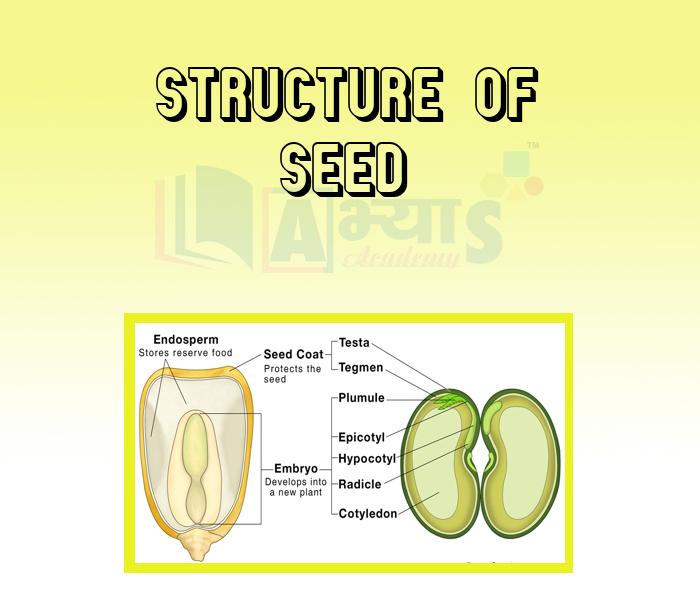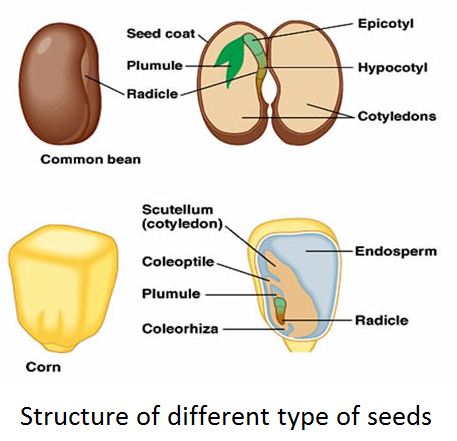Structure of Seed










Structure of Seed
An angiospermic plant can be divided into two types based on the type of seeds.The two types are :-
Dicotyledonous Seed :-
Structure of Dicotyledonous Seed : - Seed can be studied under two heads, i.e., external structure and internal structure. It is light or dark brown in colour. Its surface may be smooth or wrinkled. A small oval scar present at the side called hilum. It is the point where the stalk or funicle of the seed is attached to it. A narrow ridge called raphae runs from hilum to chalaza inside the furrow. A small pore called micropyle present between the hilum and pointed end. The outermost covering of the seed is seed coat. The outer hard and leathery layer of the coat is called testa and the inner thin and membranous layer is the tegmen. In some seeds, the tegmen and testa are fused.
The seed coat encloses the embryo, which is differentiated into radicle, a plumule and cotyledons. The radicle develops into root and plumule into shoot. Cotyledons may be one or two to serve as reserve food. Hypocotyl is a part present between the point of attachment of cotyledon and radicle. Epicotyle is present between point of attachment of cotyledons and plumule. In some seeds, such as castor seeds, the endosperm is formed as a result of double fertilisation, which is a food storing tissue. In plants like bean, gram and pea, the endosperm is not present in mature seeds (i.e., non-endospermous seeds).
Monocotyledonous Seed : -
The monocotyledonous seeds are endospermic, but some as in orchids are non-endospermic. In the cereals, such as maize, the seed coat is membranous and generally fused with the fruit wall.
Structure of Monocotyledonous Seed : - The endosperm is bulky and stores food. The outer covering of endosperm separates the embryo by a proteinous layer called aleurone layer. The embryo is small and situated in a groove at one end of the endosperm. It consists of one large shield-shaped cotyledon known as scutellum and a short axis with a plumule and a radicle. The plumule and radicle are enclosed in sheaths which are called coleoptile and coleorhiza, respectively.
Coleoptile has a terminal pore for the emergence of first leaf during germination. The sheath is capable of growth. It helps the future shoot in passing through the soil during germination, c.g., maize grain is whitish, yellow, violet or red in colour. It has smooth or shiny surface.
Its grain is covered with a single, thin hard covering. It is formed by the fusion of seed coat or testa and the fruit wall or pericarp.

Students / Parents Reviews [10]
It was a good experience with Abhyas Academy. I even faced problems in starting but slowly and steadily overcomed. Especially reasoning classes helped me a lot.

Cheshta
10thMy experience with Abhyas is very good. I have learnt many things here like vedic maths and reasoning also. Teachers here first take our doubts and then there are assignments to verify our weak points.

Shivam Rana
7thAbhyas is a complete education Institute. Here extreme care is taken by teacher with the help of regular exam. Extra classes also conducted by the institute, if the student is weak.

Om Umang
10thI have spent a wonderful time in Abhyas academy. It has made my reasoning more apt, English more stronger and Maths an interesting subject for me. It has given me a habbit of self studying

Yatharthi Sharma
10thAbhyas Methodology is very good. It is based on according to student and each child manages accordingly to its properly. Methodology has improved the abilities of students to shine them in future.

Manish Kumar
10thAbout Abhyas metholodology the teachers are very nice and hardworking toward students.The Centre Head Mrs Anu Sethi is also a brilliant teacher.Abhyas has taught me how to overcome problems and has always taken my doubts and suppoeted me.

Shreya Shrivastava
8thMy experience with Abhyas academy is very good. I did not think that my every subject coming here will be so strong. The main thing is that the online tests had made me learn here more things.

Hiya Gupta
8thOne of the best institutes to develope a child interest in studies.Provides SST and English knowledge also unlike other institutes. Teachers are co operative and friendly online tests andPPT develope practical knowledge also.

Aman Kumar Shrivastava
10thIt has a great methodology. Students here can get analysis to their test quickly.We can learn easily through PPTs and the testing methods are good. We know that where we have to practice

Barkha Arora
10thIt was good as the experience because as we had come here we had been improved in a such envirnment created here.Extra is taught which is beneficial for future.
